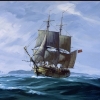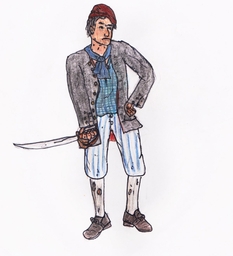-
Posts
1,118 -
Joined
-
Last visited
Content Type
Profiles
Forums
Events
Gallery
Everything posted by Swashbuckler 1700
-
Good point. I see that a lot in the medical journals. They often call the same surgical tool by several different names...sometimes in the same text. For example, I've seen the amputation knife called that, the capital knife, the crooked knife or blade and the curved knife among other things. There is always many names for everything....always..... often things get names afterwards like these petticoat-breeches or even pirates like Black Bart (which was nickname for B. Robets but was not used in his life time)... same with golden age of pyracy which is around 20th century invention.... While true, if you're re-enacting, you try to avoid using modern monikers if you know better. (I shall have something to say about the use of the word 'tourniquet' in English medicine in an upcoming web page, for example). I think Ed's original point it a good one. During period there was far less need to uniquely identify and label things. Considering that medicine was a somewhat scientific field. the fact that the authors of the time didn't agree on what to call something so central to their practice as a amputation knife is rather telling. This suggests to me that you might go into a cutlery shop and explain what you wanted so they could make you one rather than just asking for an amputation knife. Strict standardization doesn't seem to have been part of their lexicon, let alone their production. well I am not actual reenactor....
-
Do you have any period evidence of this? (Not suppositions from a post-period author trying to make a case for his pet belief. There's a lot of that out there.) well I have not studied much records (since I have no good access to those) but some (good but not flawless) book said so... I am certain of that that happened but I try to find some evidence...
-
perhaps bit of of topic but when we wonder illustrations here:.... but always when I look that petticoat breeches picture (latter one) I see those fur hats as wigs .... actually if hat is so furry where is the line between wig and hat ..
-
Good point. I see that a lot in the medical journals. They often call the same surgical tool by several different names...sometimes in the same text. For example, I've seen the amputation knife called that, the capital knife, the crooked knife or blade and the curved knife among other things. There is always many names for everything....always..... often things get names afterwards like these petticoat-breeches or even pirates like Black Bart (which was nickname for B. Robets but was not used in his life time)... same with golden age of pyracy which is around 20th century invention....
-

Matchlock firearms in golden age of piracy
Swashbuckler 1700 replied to Swashbuckler 1700's topic in Armory
Not to take things sideway, but cannon in the period did not use fuses. They were fired by what is called hotshotting- putting fine grained powder firectly into the vent. On the original topic, the last matchlocks were not withdrawn from service in the British Army until 1711. That said, the matchlock is very much a military weapon, and civilians took to the firelock (flinlock, doglock, English lock, miquelet) long before the military. As early as the Mass Bay colony in the 1620's-1630's, colonists were recommended to acquire a firelock if at all possible, Hawkyns Thanks... Well bit of topic... but was it stick with match that was used to ignite powder in the cannon vent. see there is match on the stick here Below linstocks had fuse to ignite powder (see the pic above it is period pic and it has similar stick) -
what you believe about this: I believe that even some pirates had their investors… let’s say some Carolinian merchant invested some money to pirates that they Gould get to the trip, and make a pact that he would get some loot cheaper… What I mean that: at least both privateering and pirating were both organized business with all those articles and so on… I have also read that often people invested to privateers that they would know to become pirates just after they had left the port… I am not saying that there were no difference between pirates and privateers since they were lots of those differences...
-
Ok interesting....
-
Since this topic has gone to trousers I think some more pants question would not hurt much ... What is difference between petticoat-breeches and slop-breeches is there any ? (above sailor in 1690s.) Is there any difference?
-
well I actually knew that but really good that you explained it clearly since I was bit unsure....
-
You mean stuff like: jackets, breeches, hats, monmouth caps. other caps etc. I could have figured that myself... but thanks I just wanted to know were there difference between navy and merchant sailors clothing...
-
It seems to me that there is no image from earlier time than 1725 even that trousers had been around some time… too bad that there is so few pictures from gaop ( but fortunately there is plenty of documents ) …. Here are illustrations from Dutch version of GHoP from 1725… and all know those Bonny and Read pictures …. That there is trousers in Dutch illustrations of English pirates leads me once again to point that illustrators had some kind of understanding what they were descripting… like in here in this period only Englishmen used long trousers and Dutch illustrator knew that (although he exaggerated popularity of trousers) … I am NOT saying that there was no artistic liberties/interpretation in illustrations. I am just meaning that with bit of criticism you can use period art as source … but I believe that we are done with that...
-
So they were so normal in that age (but breeches were more common).. were those canvas trousers or someting else? ... sorry that I ask but could you answer me in "merchant slops" topic because you are one of those clothing experts here...
-

Matchlock firearms in golden age of piracy
Swashbuckler 1700 replied to Swashbuckler 1700's topic in Armory
well in cannons needed fuses still... -
What is the date of that? when the long trousers started to be common among sailor... to my knowledge one of first evidence of their use was in Bonny's and Reads's court statement when eyewitness Dorothy Thomas said that they “wore Mens Jackets, and long Trouzers, and Handkerchiefs tied about their Heads; and that each of them had a Machet and Pistol in their Hands.” but is there earlier mentions of trousers?
-
Still the question: what kind clothing merchant ship's stores would have included? remains....
-
What books do you mean?
-
Yeah... but I was wondering: what kind clothing merchant ship's stores would have included?
-
Good points there...
-
From the album: Realistic pirate art
-
yes yes... but in privateering money was often greater incentive for the fatherland, or religion...(but for example Drake hated the Pope and catolics and was real patriot)
-
I am just curios.... what kind of clothing? was that were the stuff from slop shops (like that 1699) went? or was there someting to do with navy slops?
-
Many privateer Like Drake or Morgan were part-time pirates when they operated agains Spaniards even during the peace and so they violated the terms of letters of marque...W. Kidd that is nowdays know as legendary pirate was perhaps only privateer since "the Quedah Merchant" was sailing under Frech passports and it was his only real price (and his Letter of marque was agains pirates or Frech) ... often pirate turned privateers or privateers to pirates.. For example Woodes Roger was about to put John Rackhan as privateer captain agains spaniards and S. Bonnet wanted to get letters of marque from Danish island of St. Thomas .... there is just small gap between privateer or pirate....
-
I know that quote... it is good reference for stolen clothing...
-
So If wounted soldier would used those (practically in same time period) why not wounted sailor or pirate alike but certainly they were rare... and Foxe has your stance toward wooden legs changed after you wrote this: http://www.piratesin...legends_944.asp ?
-
Yes Yes I know but still... My point to that privateer debate is that as privateer captain has law on his side and he can rob only enemy ships but as virtually it is almost same...


